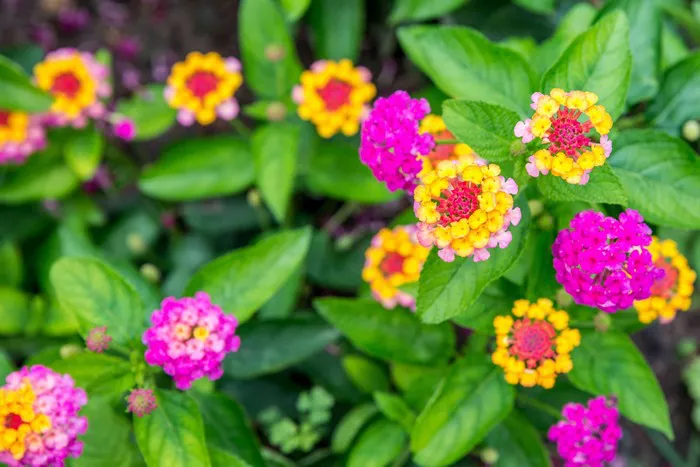Lantana, with its vibrant blooms and easy-to-care-for nature, is a popular choice for gardens, landscaping, and container gardening. Its clusters of colorful flowers attract bees, butterflies, and hummingbirds, making it a favorite among pollinators. But what exactly do lantana flowers look like, and what makes them so unique? In this comprehensive guide, we’ll explore the appearance of lantana flowers, their colors, shapes, and other distinctive features.
Lantana Flowers: A Visual Delight
Lantana flowers are renowned for their beauty and diversity. They come in a wide range of colors, from vibrant yellows and oranges to rich purples and reds. One of the most striking characteristics of lantana flowers is their clusters, known as umbels, which consist of numerous small blooms tightly packed together.
Color Variations
Lantana flowers exhibit an impressive array of colors, often within the same cluster. Each tiny flower within the umbel typically has a single color, but as the clusters mature, they can display a stunning gradient effect, transitioning from one color to another. Common color variations include:
1. Yellow: Lantana flowers in shades of yellow range from pale lemon to bright gold. Yellow lantanas are often associated with warmth and cheerfulness, making them a popular choice for sunny gardens and landscapes.
2. Orange: Shades of orange in lantana flowers can vary from soft peach to deep tangerine. Orange lantanas add a burst of color to any garden and are particularly attractive to butterflies.
3. Red: Lantana flowers in shades of red encompass hues such as crimson, scarlet, and burgundy. Red lantanas are striking and eye-catching, making them a focal point in any landscape design.
4. Pink: Pink lantana flowers range from delicate pastel shades to vibrant magenta. Pink lantanas evoke feelings of romance and femininity, making them a popular choice for garden borders and containers.
5. Purple: Lantana flowers in shades of purple include hues such as lavender, violet, and deep plum. Purple lantanas add a touch of elegance and sophistication to any garden setting.
6. White: While less common, lantana flowers can also be found in shades of white. White lantanas offer a sense of purity and tranquility, and their blooms often emit a subtle, sweet fragrance.
Shape and Structure
In addition to their vibrant colors, lantana flowers boast unique shapes and structures that contribute to their visual appeal. Each tiny flower consists of five petals arranged in a tubular shape, with a central cluster of stamens protruding from the center. The petals may be smooth or slightly ruffled, depending on the variety.
The umbels, or clusters, of lantana flowers can vary in size and density. Some varieties produce compact clusters with numerous blooms packed closely together, creating a dense, spherical shape. In contrast, other varieties feature more open clusters with fewer blooms, resulting in a looser, more airy appearance.
Foliage
In addition to their colorful blooms, lantana plants are characterized by their dense, dark green foliage. The leaves are typically oval-shaped with serrated edges and grow in pairs along the stems. The foliage provides an attractive backdrop for the vibrant flowers and adds to the overall visual impact of the plant.
One of the unique features of lantana foliage is its aromatic scent. When the leaves are crushed or brushed against, they release a distinctive fragrance that is often described as citrusy or spicy. This fragrant foliage adds another dimension to the sensory experience of growing lantanas.
Growth Habits
Lantana plants exhibit a bushy, spreading growth habit, making them ideal for use as ground covers, borders, or container plants. Depending on the variety, lantanas can range in height from one to six feet tall, with a similar spread. They tend to grow quickly and can become somewhat woody with age.
Lantanas are considered perennial plants in warm climates but are often grown as annuals in cooler regions. They thrive in full sun and well-drained soil, although they can tolerate a variety of soil types, including sandy or rocky soils. With their drought tolerance and resistance to pests and diseases, lantanas are relatively low-maintenance plants, making them a popular choice for gardeners of all skill levels.
Cultural Significance
Beyond their ornamental value, lantana flowers hold cultural significance in various parts of the world. In some cultures, lantanas are associated with love and romance, while in others, they symbolize happiness and good fortune. Additionally, certain species of lantana have been used in traditional medicine for their purported healing properties.
In parts of Africa, lantana plants are considered invasive and are actively managed to prevent them from spreading and disrupting native ecosystems. Despite their beauty, some species of lantana have aggressive growth habits and can outcompete native vegetation, posing a threat to biodiversity.
Conclusion
Lantana flowers are prized for their vibrant colors, unique shapes, and easy-care nature. From sunny yellows to deep purples, lantanas offer a rainbow of hues to brighten any garden or landscape. With their bushy growth habit and attractive foliage, lantanas provide year-round interest and make a versatile addition to any outdoor space.
Whether used as ground covers, borders, or container plants, lantanas are sure to delight gardeners and admirers alike with their stunning blooms and enticing fragrance. By understanding the appearance and characteristics of lantana flowers, gardeners can harness the full potential of these beautiful plants to create captivating landscapes that burst with color and vitality.


